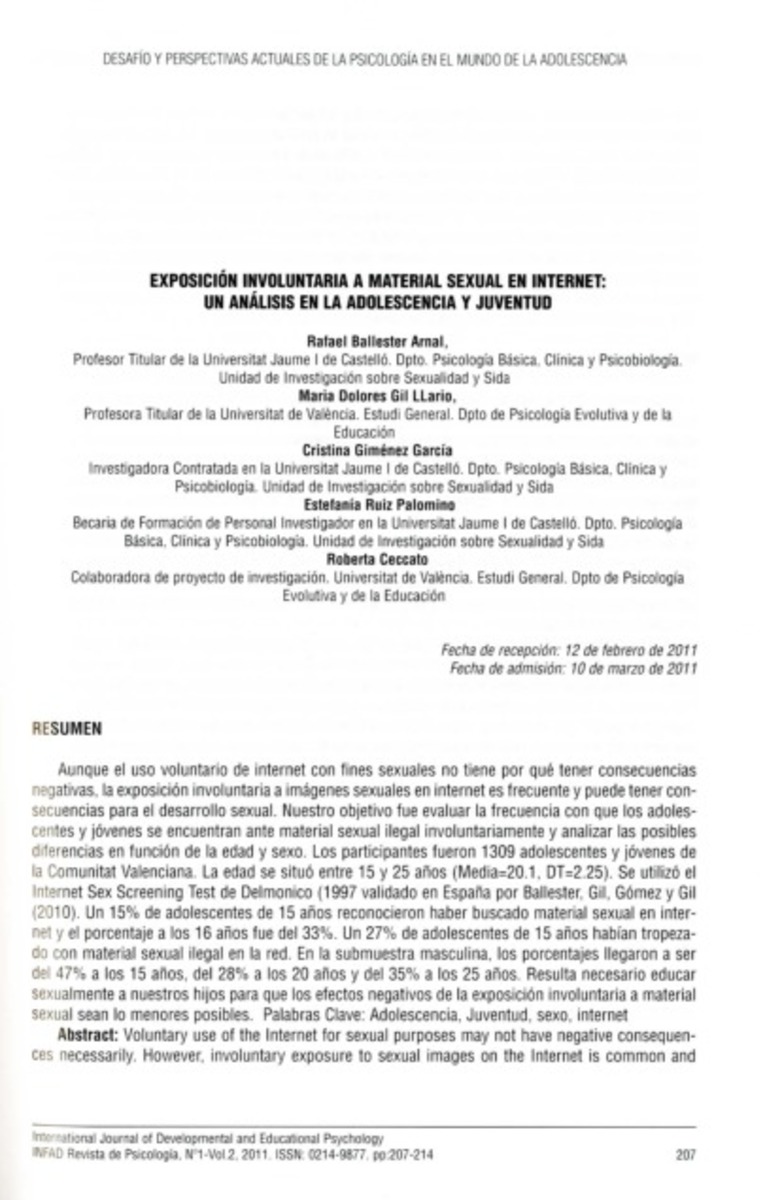Mostrar el registro sencillo del ítem
Exposición involuntaria a material sexual en Internet: un anàlisis en la adolescencia y juventud
| dc.contributor.author | Ballester-Arnal, Rafael | |
| dc.contributor.author | Gil-Llario, MD | |
| dc.contributor.author | Giménez-García, Cristina | |
| dc.contributor.author | Ruiz-Palomino, Estefania | |
| dc.contributor.author | Ceccato, Roberta | |
| dc.date.accessioned | 2013-03-08T10:42:58Z | |
| dc.date.available | 2013-03-08T10:42:58Z | |
| dc.date.issued | 2011 | |
| dc.identifier.citation | International Journal of Developmental Educational Psychology INFAD Revista de Psicología (2011), nº 1, vol. 2, p. 207-214 | ca_CA |
| dc.identifier.issn | 0214-9877 | |
| dc.identifier.uri | http://hdl.handle.net/10234/59826 | |
| dc.description.abstract | Voluntary use of the Internet for sexual purposes may not have negative consequences necessarily. However, involuntary exposure to sexual images on the Internet is common and may have implications for sexual development. Our objective was to assess the frequency with whom adolescents and youth could find illegal sexual material accidentally, as well as to analyze the differences by age and sex. Participants were 1,309 adolescents and youth from the Comunitat Valenciana (Spain), whose age ranged between 15 and 25 years (Mean = 20.1 , SO = 2.25). We used the Internet Sex Screening Test Delmonico (1997) which was validated in Spain by Ballester, Gil, Gómez & Gil (2010). About 15% of adolescents aged 15 years reported they had sought sexual material on the Internet and the percentage was 33% at 16 years. 27% of adolescents aged 15 years had found illegal sexual material on the network unintentionally. In the male subset, the percentages were 47% at 15 years, 28% at 20 years and 35% at the age of 25. lt is necessary to provide sexual education to our children, so that the negative effects of the involuntary exposure to sexual material may be as minor as possible. | ca_CA |
| dc.description.abstract | Aunque el uso voluntario de internet con fines sexuales no tiene por qué tener consecuencias negativas, la exposición involuntaria a imágenes sexuales en internet es frecuente y puede tener consecuencias para el desarrollo sexual. Nuestro objetivo fue evaluar la frecuencia con que los adolescentes y jóvenes se encuentran ante material sexual ilegal involuntariamente y analizar las posibles diferencias en función de la edad y sexo. Los participantes fueron 1309 adolescentes y jóvenes de la Comunitat Valenciana. La edad se situó entre 15 y 25 años (Media=20.1, 01=2.25). Se utilizó el Internet Sex Screening Test de Delmonico (1997), validado en España por Ballester, Gil, Gómez y Gil (2010). Un 15% de adolescentes de 15 años reconocieron haber buscado material sexual en internet y el porcentaje a los 16 años fue del 33%. Un 27% de adolescentes de 15 años habían tropezado con material sexual ilegal en la red. En la submuestra masculina, los porcentajes llegaron a ser del 47% a los 15 años, del 28% a los 20 años y del 35% a los 25 años. Resulta necesario educar sexualmente a nuestros hijos para que los efectos negativos de la exposición involuntaria a material sexual sean lo menores posibles. | ca_CA |
| dc.format.extent | 8 p. | ca_CA |
| dc.format.mimetype | application/pdf | ca_CA |
| dc.language.iso | spa | ca_CA |
| dc.publisher | Asociación Nacional de Psicología Evolutiva y Educativa de la Infancia, Adolescencia y Mayores (INFAD) | ca_CA |
| dc.rights | © Asociación Nacional de Psicología Evolutiva y Educativa de la Infancia, Adolescencia, Mayores y Discapacidad | ca_CA |
| dc.rights.uri | http://rightsstatements.org/vocab/InC/1.0/ | * |
| dc.subject | adolescence | ca_CA |
| dc.subject | youth | ca_CA |
| dc.subject | sex | ca_CA |
| dc.subject | internet | ca_CA |
| dc.subject | adolescencia | ca_CA |
| dc.subject | juventud | ca_CA |
| dc.subject | sexo | ca_CA |
| dc.title | Exposición involuntaria a material sexual en Internet: un anàlisis en la adolescencia y juventud | ca_CA |
| dc.type | info:eu-repo/semantics/article | ca_CA |
| dc.rights.accessRights | info:eu-repo/semantics/openAccess | ca_CA |
| dc.type.version | info:eu-repo/semantics/publishedVersion | ca_CA |
Ficheros en el ítem
Este ítem aparece en la(s) siguiente(s) colección(ones)
-
PSB_Articles [1330]
Articles de publicacions periòdiques







